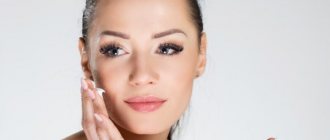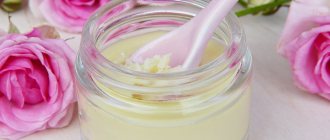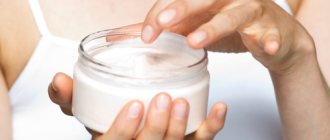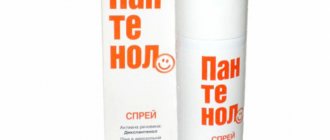Dexpanthenol is a substance derived from the water-soluble B vitamin - pantothenic acid. It is this that the body’s need increases when the skin and tissues are damaged. To compensate for the lack of substance and accelerate cell regeneration, use the topical drug D-Panthenol.
Types of dosage forms, composition
D-Panthenol is available in the form of ointment and cream. 1 g of both forms contains 50 mg of dexpanthenol.
D-Panthenol cream has a white color, a uniform structure, and no pungent odor. It is packaged in tubes of 25 or 50 g, which are sold in boxes with instructions. Additional ingredients include propylene glycol, methyl parahydroxy- and propyl parahydroxybenzoate, macrogol cetostearate, cetostearyl alcohol, paraffin, petroleum jelly, sodium hydrogen phosphate dodecahydrate, potassium dihydrogen phosphate, purified water.
D-Panthenol ointment has a white color with a yellowish tint, a thicker structure and a faint odor. It is packaged in 30 g aluminum tubes, which are placed in a box complete with instructions. In addition to dexpanthenol, it contains glycerin, lanolin, petroleum jelly, liquid and solid paraffin, stearyl and cetyl alcohols, and water.
Related materials:
Steblanc | The Oozoo | Dr. Jart+ | Clinique | The Chemical Barbers | Secret ingredient | ingredients | Panthenol | provitamin | vitamin b5 | Steblank | Doctor Zhart+
Articles
- A new word in makeup: strobing June 30, 2015, 00:00
- Vertical wrinkles: how to get rid of them? October 16, 2015, 00:00
- Secret ingredient: snail mucin February 07, 2022, 00:00
Video
- Laser effect from Clinique November 09, 2010, 00:00
- Vitamin cocktail from Dr.Jart+ - A new level of cosmeceuticals November 22, 2012, 09:34
- Salon deep cleansing procedure at home from STEBLANC December 21, 2022, 08:00
Indications for use of D-Panthenol
Everyone needs to know what D-panthenol ointment is used for. The main reasons for use are a variety of mild skin damage resulting from temperature, mechanical or chemical exposure. Indications include:
- skin burns, including those resulting from sunburn;
- wounds in the form of abrasions and scratches;
- dermatitis;
- uncomplicated diaper dermatitis in infants and its prevention;
- treatment and prevention of nipple injury during breastfeeding;
- dryness and tightness of the skin
Depanthenol cream is used to protect the epidermis from the effects of frost and wind, for the prevention and treatment of diaper rash, when treating the skin around the openings for the removal of colostomy, tracheostoma or gastrostomy.
The ointment is used in the treatment of bedsores, trophic ulcers, anal fissures, and non-infected wounds after surgical interventions.
Where is panthenol used?
- In cosmetics, Panthenol in cosmetics has earned a reputation as a powerful external restorative, healing, moisturizing agent. In cosmetic formulas, vitamin B5 is found in the form of pantothenic acid derivatives: D- and L-panthenols. Often used in soothing products for sensitive, dry, oily and problematic facial skin, as well as in after-sun formulas. Its ability to stimulate the synthesis of collagen and elastin, reduce facial wrinkles, and smooth out skin texture allows the use of panthenol as part of anti-aging corrective care. Shampoos, balms and masks with provitamin B5 for hair improve hair structure, stimulate growth, prevent irritation and dryness of the scalp.
- In cosmetology Since the key function of dexpanthenol is the regeneration of the skin, in cosmetology products based on it are used mainly after traumatic aesthetic procedures, for example, chemical peels, photoepilation, laser resurfacing, during which the integrity of the epidermal layer of the skin is damaged. Panthenol-containing creams, gels, masks help quickly soothe and moisturize damaged skin, relieve swelling and swelling of tissues, shorten the rehabilitation period and prevent complications.
Effects of the drug
The main effect of the drug is to help in tissue regeneration. The medication also has the following positive effects:
- relieves inflammation at the site of violation of the integrity of the skin;
- reduces irritation, including after cosmetic procedures;
- restores and moisturizes the skin, fights peeling;
- helps wounds heal faster;
- promotes faster renewal of the skin in case of burns;
- relieves chafing and redness.
Panthenol - what is it?
Panthenol, or pantothenic acid
– water-soluble vitamin B5 (dexpanthenol) with low molecular weight and high ability to penetrate into the deep layers of the skin.
Pantothenic acid was discovered in the 30s of the 20th century and almost immediately found application in pharmacology due to its pronounced anti-inflammatory, regenerating, and soothing properties. The ability to accelerate tissue renewal, maintain their firmness and elasticity, smooth out wrinkles, soften and moisturize the epidermis has allowed vitamin B5 to take first place among components for facial and body skin care. Today, panthenol for the face is one of the key components and helps solve several skin problems at once.
How to use, what is best to use
Instructions for use of D-Panthenol ointment and cream contain recommendations to use the product 2-4 times a day or more often. Apply the required amount of the substance with light rubbing movements to the affected area of dry skin.
If the application site is infected, then pre-treatment with an antiseptic - Miramistin or Chlorhexidine - is required; it is not advisable to use hydrogen peroxide.
Ointment and cream differ in their texture: the ointment is based on fatty components that create a protective film on the surface that softens and nourishes the skin. Therefore, it is better to use the ointment to prevent diaper rash, frostbite, and dermatitis in infants.
The cream is more liquid because it contains water. It is absorbed easier and faster, therefore it is indicated for mild frostbite, thermal burns, and for protection from harmful weather factors.
Forms of release of cosmetics with panthenol
Depending on the type and needs of the skin, there are several formats of cosmetic products containing panthenol. For oily and combination skin, choose water-based products with light textures - gels, serums, fluids, balms. For dry skin, nourishing products containing lipid-restoring formulas and oils, such as rich creams, are suitable.
Often panthenol can be found in the base of foundations or correctors, lipsticks or balms, for example, in the composition of Cicaplast restoring lip barrier balm. Shampoos, conditioners, and masks with panthenol are produced for hair.
Use in children and pregnant women
Pregnancy and breastfeeding are not an obstacle to using D-Panthenol for external use. The substances of the drug do not penetrate the placenta and do not have a negative effect on the process of formation and development of the fetus.
The cream or ointment is recommended for use by women when caring for the mammary glands: it is necessary to lubricate the nipples after each application to the breast to prevent microcracks and injuries.
For children, the product can be used from birth; the cream or ointment is applied to the skin under the diaper at each diaper change or after hygiene procedures. For older children, D-Panthenol will help quickly heal minor cuts, abrasions, and scratches.
special instructions
When using the drug, you should consider the following features:
- the product does not help fight purulent wounds, in which case more effective drugs will be needed;
- if the surface of the damaged skin constantly gets wet, then there is no point in using the product;
- Panthenol can provoke an allergic reaction, so before use you should apply a little product to a healthy area of skin and wait a day. If there is no reaction, then you can use it for its intended purpose.
The drug is allowed to be used by pregnant women. It is absolutely non-toxic, intended for external use and is not able to penetrate the bloodstream or affect organs. Panthenol will not affect the health of the expectant mother and her baby in any way.
Analogs
Level 4 ATC code matches:
Panthenol
Kalanchoe juice
Aloe liniment
Levomekol
Pantestin-Darnitsa
Dexpanthenol
Contractubex
Pantoderm
Bepanten
Structural analogues by ATC code and active substance: Bepanthen ; Dexpanthenol ; Panthenol Pharmstandard; Korneregel ; Panthenol-ratiopharm ; Moreal-plus ; Panthenol ; Panthenolspray ; Pantoderm .
Contraindications and side effects
Panthenol is a safe medicine, so it is used even for infants against diaper rash. However, before you start using it, you need to study the contraindications for use. There are few of them:
- the presence of individual intolerance to the components of the drug;
- renal failure;
- high tendency to allergic reactions;
- permanent occurrence of fever due to infectious or systemic diseases;
- herpes in the acute stage.
The use of the drug in the presence of contraindications is prohibited.
It is also necessary to discontinue further use of Panthenol cream if the following symptoms appear after application to the skin:
- allergic redness;
- itching in the area of application;
- peeling of the skin;
- swelling;
- skin inflammation.
Important: before using Panthenol for the face, you must conduct an allergy test. A small amount of the drug is applied to the wrist for 10-15 minutes.
- If there are no unpleasant sensations, no itching, redness, or rashes, further use of the cream is acceptable.
- If an allergic reaction occurs, it is necessary to wash off the cream with warm water and stop using it. If necessary, consult a specialist.
Pharmacodynamics and pharmacokinetics
Dexpanthenol - what is it?
Dexpanthenol is an alcohol analogue of pantothenic acid , which, when biotransformed in the body, provides the same effects as pantothenic acid ( pantothenate or vitamin B5 ).
When it comes into contact with the skin, the substance is quickly absorbed into the tissues, turning into its active form - vitamin B5 (water-soluble in group B itamin ).
The latter, in turn, is part of the specific coenzyme CoA, which is the main regulator of metabolic processes (Krebs cycle, metabolism of fatty acids, fats, carbohydrates, proteins, phospholipids, etc.), ensures the acetylation of choline and the formation of corticosteroids.
Pharmacodynamics and pharmacokinetics
Pantothenate , dexpanthenol and their anhydrous salts are water-soluble vitamins . They actively participate in fat, carbohydrate and energy metabolism, and also perform an important function in the processes of oxidation and acetylation.
During metabolic processes, it interacts with B-group vitamins . Participates in the formation of epithelial tissue and ensures its normal functioning, reduces itching and exhibits weak anti-inflammatory activity.
When applied topically, the drug allows you to compensate for the increased need of damaged skin and/or mucous membranes for pantothenic acid.
The active substance is absorbed by the skin.
pantothenate entering the body with food is 50%. In the body, the substance is transported through the formation of bonds with plasma proteins (mainly albumin and β-globulins ).
In healthy adults, the concentration of pantothenic acid in the blood when applied topically is 0.5-1 mg/ml, in the blood serum - 0.1 mg/ml.
The active substance is not metabolized in the body (exception is inclusion in Co-A). About ⅔ of pantothenic acid entering the body unchanged (about 70%) is excreted by the kidneys, the remaining amount is excreted in feces.
Interaction
When used locally according to indications, interaction with other drugs is unknown.
When applying the spray to the anal area or genitals in the case of using condoms, it reduces the strength of the latter when breaking. This is due to the fact that this dosage form of the drug contains mineral oil.
There is evidence that dexpanthenol, when taken orally and parenterally, prolongs the effects of succinylcholine .
The use of an injection solution in combination with general anesthesia, barbiturates and antibacterial drugs increases the risk of developing hypersensitivity reactions.











